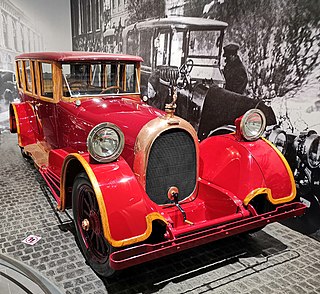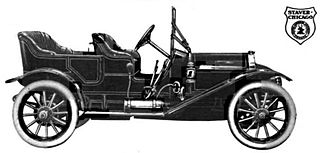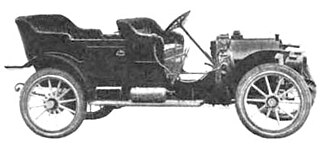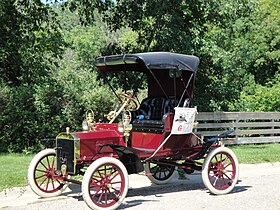
The Saxon Motor Car Company was located in Detroit, Michigan, from 1914 to 1922. In 1917, 28,000 cars were made, making it the seventh largest car maker in the United States.

The Ford Model C is an automobile that was produced by Ford Motor Company. Introduced in 1904, it was a revision of the Model A with a more modern appearance. It had a slightly more powerful engine and a 6-in-longer wheelbase. Built at the Ford Piquette Avenue Plant, it was the entry-level car in the Ford model lineup, slotting below the upscale Model B. Production ended in 1905 with 800 cars made; it was replaced by the derivative Model F.

The Ford Model F is an automobile produced by Ford. It was a development of the Model A and Model C, but was larger, more modern, and more luxurious. Production started in 1905 and ended in 1906 after about 1,000 were made. It was built at the Ford Piquette Avenue Plant. It was a four-seater phaeton with running boards and a side-entrance tonneau standard. It was priced from US$1,000 to US$1,200 ; by contrast, the Colt Runabout was $1,500, the FAL was $1,750, the Cole 30 $1,500, the Enger 40 $2,000, and the Lozier Light Six Metropolitan $3,250. All had green bodies.

Velie was a brass era American automobile brand produced by the Velie Motors Corporation in Moline, Illinois from 1908 to 1928. The company was founded by and named for Willard Velie, a maternal grandson of John Deere.

Elmore Manufacturing Company was a manufacturer of veteran and brass era automobiles and bicycles (1893–97), headquartered at 504 Amanda Street, Clyde, Ohio, from 1893 until 1912. The company took its name from a small parcel of land in Clyde with the name Elmore associated with it where a stave mill was established originally, then evolved into bicycle production. The village of Elmore, Ohio is located 20 mi (32.2 km) to the east. Founded by Harmon Von Vechten Becker and his two sons, James and Burton, the Elmore used a two-stroke engine design, in straight twin or single-cylinder versions. They later produced a straight-3 followed by a straight-4 beginning in 1906 until production ended in 1912. The company advertising slogan was "The Car That Has No Valves", referring to the two-stroke engine.

Templar was a manufacturer of automobiles in Lakewood, Ohio from 1917 to 1924. The company was named for the Knights Templar and used a Maltese Cross as an emblem.

Heine-Velox was a large, expensive luxury car made by Gustav Heine. Heine Piano Company was originally Bruenn Piano Company before Heine became owner. All were based in San Francisco.

The Staver was an American automobile manufactured at 76th and Wallace Streets in Chicago, Illinois, by the Staver Carriage Company from 1907 until 1914. It was also known as the Staver Chicago or Staver-Chicago.

The Haynes Automobile Company was an American automobile manufacturing company that produced automobiles in Kokomo, Indiana, from 1905 to 1924. The company was formerly known as the Haynes-Apperson company, and produced automobiles under that name from 1896 to 1905. Co-founder Elwood Haynes changed the name of the company after fellow co-founders Elmer and Edgar Apperson left to form the Apperson Brothers Automobile Company in 1901. The company was declared bankrupt in 1924 and went out of business in 1925.

The Herreshoff was an automobile built in both Detroit, Michigan, and Troy, New York, by the Herreshoff Motor Company from 1909 to 1914. The Herreshoff started as a small car with a 24 hp (18 kW) four-cylinder engine, and was made with three different models. Later models were upgraded to six-cylinder engines up to 3.8 liters capacity. For 1911, Herreshoff had a roadster with a rudimentary rumble seat at US$950 ; by contrast, the high-volume Oldsmobile Runabout went for US$650, the Ford Model N and Western's Gale Model A were US$500, the Black was $375, and the Success, US$250.

Scripps-Booth was a United States automobile company based in Detroit, Michigan. Established by James Scripps Booth in 1913, Scripps-Booth produced motor vehicles and was later acquired by General Motors, becoming a division of it, until the brand was discontinued in 1923.
The Austin was a brass era American automobile manufactured in Grand Rapids, Michigan from 1901 to 1921. The company, founded by James E. Austin and his son Walter Austin, built large, expensive and powerful touring cars with an unusual double cantilever rear spring arrangement placing the rear wheels behind the passenger compartment, for a longer wheelbase to improve rider comfort in an era of rough roads as well as a unique two-speed rear axle.

Western Tool Works was a pioneering brass era automobile manufacturer in Galesburg, Illinois. The company made Gale automobiles from 1904 to 1910. Early Gale runabouts were notable for having bodywork hinged at the rear of the car that could be lifted to ease access to the engine, essentially making the entire body the hood.
The Success Automobile Manufacturing Company was a brass era United States automobile manufacturer, located at 532 De Ballviere Avenue, St. Louis, Missouri, in 1906.

The Black was a brass era United States automobile, built at 124 East Ohio Street, Chicago, Illinois, in 1906.
The Colt Runabout was an American Brass-era automobile, built in Yonkers, New York, in 1907. by William Mason Turner.
Vulcan Manufacturing Company was a brass era American automobile manufacturer based in Painesville, Ohio, founded in 1914.

Daniels Motor Company was a pioneer brass era American automobile company, founded in 1915 by George E. Daniels with Neff E. Parish. George Daniels was a known lawyer, engineer, and mechanic. He was considered the best motorcar designer in the United States. Neff Parish had his own automobile parts and framing manufacturing company. Neff was the creator of the time's highest-grade heat-treated alloy steel frames, respected in the steel industry. Daniels Motor Company produced 1,500 high quality automobiles between 1916-1924, branding themselves as “the distinguished car with just a little more power than you will ever need”, and “The aristocrat of American cars”.
The American Automobile and Power Company was an American Brass Era car manufacturer, incorporated in Sanford, Maine, in 1903. They produced the American Populaire during 1904 and 1905.

Hatfield Motor Vehicle Company was a pioneer brass era American automobile company, built in Miamisburg, Ohio, in 1907 and 1908.
















